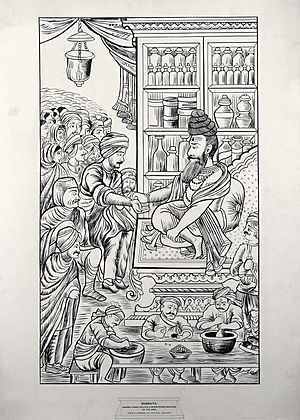Sushruta facts for kids
Quick facts for kids
Maharshi
Sushruta
|
|
|---|---|

Sketch of Sushruta
|
|
| Born | c. mid 1st millennium BCE Kingdom of Kashi
|
| Known for | Author of Sushruta Samhita |
|
Notable work
|
|
| Scientific career | |
| Institutions | Banaras University |
Sushruta, or Suśruta (Sanskrit: सुश्रुत, IAST: Suśruta, lit. well heard) was an ancient Indian physician. The Sushruta Samhita (Sushruta's Compendium), a treatise ascribed to him, is one of the most important surviving ancient treatises on medicine and is considered a foundational text of Ayurveda. The treatise addresses all aspects of general medicine, but the impressive chapters on surgery have led to the false impression that this is its main topic. The translator G. D. Singhal dubbed Suśruta "the father of surgery" on account of these detailed accounts of surgery.
The Compendium of Suśruta locates its author in Varanasi, India.
Date
The early scholar Rudolf Hoernle proposed that some concepts from the Suśruta-saṃhitā could be found in the Śatapatha-Brāhmaṇa, which he dates to the 600 BCE, and this dating is still often repeated. However, during the last century, scholarship on the history of Indian medical literature has advanced substantially, and firm evidence has accumulated that the Suśruta-saṃhitā is a work of several historical layers. Its composition may have begun in the last centuries BCE and it was completed in its present form by another author who redacted its first five chapters and added the long, final chapter, the "Uttaratantra". It is likely that the Suśruta-saṃhitā was known to the scholar Dṛḍhabala (fl. 300–500 CE), which gives the latest date for the version of the work that has come down to us today. It has also become clear through historical research that there are several ancient authors called "Suśruta" who might be conflated.
Followers
Sushruta attracted a number of disciples who were known as Saushrutas and were required to study for six years before they even began hands-on training in surgery. Before starting their training, they had to take a solemn oath to devote themselves to healing and to do no harm to others;which can be compared to Hippocratic Oath. After the students had been accepted by Sushruta, he would instruct them in surgical procedures by having them practice cutting on vegetables or dead animals to perfect the length and depth of an incision. Once students had proven themselves capable with vegetation, animal corpses, or with soft or rotting wood – and had carefully observed actual procedures on patients – they were then allowed to perform their own surgeries. These students were trained by their master in every aspect of the medical arts, including anatomy.
Sushruta on medicine and physicians
Sushruta wrote the Sushruta Samhita as an instruction manual for physicians to treat their patients holistically. Disease, he claimed (following the precepts of Charaka), was caused by imbalance in the body, and it was the physician's duty to help others maintain balance or to restore it if it had been lost. To this end, anyone who was engaged in the practice of medicine had to be balanced themselves. Sushruta describes the ideal medical practitioner, focusing on a nurse, in this way:
That person alone is fit to nurse, or to attend the bedside of a patient, who is cool-headed and pleasant in his demeanor, does not speak ill of anyone, is strong and attentive to the requirements of the sick, and strictly and indefatigably follows the instructions of the physician. (I.34)
Legacy
The highlight of Sushruta's surgical magnificence was the surgery of nasal reconstruction or rhinoplasty (repairing the disfigured nose with a flap of skin from the forehead) that he used to reconstruct noses that were amputated as a punishment for crime. The technique is practised almost unchanged to this day, the pedicled forehead flap being named the Indian flap. This knowledge of plastic surgery existed in India up to the late 18th century as can be seen from reports in the Gentleman's Magazine, London, October 1794.
See also
 In Spanish: Súsruta para niños
In Spanish: Súsruta para niños


